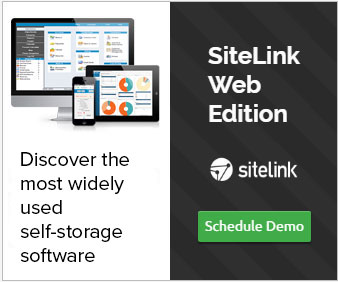Self-Service for Self-Storage
Written by Chuck Vion on June 01, 2017 under Automation & Lease Agreement & Customer Insights

Kiosks and Websites: Rent More, Boost Customer Experience
The self-service concept continues to grow all around us—airport check-ins, ATMs, and many restaurants have adopted this technology in some way. Even apartment rental marketers are looking at the untapped potential of kiosks to reach new customers.
Given the trend in automation, it’s not a surprise that self-storage operators increasingly rely on kiosks to service clients and sell products. However, those who successfully integrate this technology into their operations do not depend on it exclusively. Instead, winning solutions in the storage industry offer a mix of technology and human interaction (the option to “speak to a representative” still goes a long way). So how does self-service fit into the self-storage industry?
There is no one-size-fits-all kiosk, since the breadth of features and purpose of kiosks has grown since the first model appeared in self-storage in the early 2000s. There is a range of kiosk products available, including types made for indoor use only, and ones that can stand up to the elements. Many operators use kiosks to complement managers by offering faster service during peak hours, servicing customers after hours, and accommodating those who know exactly what they want and prefer to help themselves. Outdoor kiosks are open 24/7 and can handle payments, reservations and even rentals. This appeals to owners with unstaffed stores who rely on kiosks to handle onsite rentals. Additionally, some kiosks are tied to a call center offering live help to those who have questions.
There are several kiosk providers to choose from today, including OpenTech Alliance and CallPotential. Both have a sizable client base with many success stories to share. Owners would be well advised to research them to understand features such as reservation completion and integration with SiteLink eSign™ rental agreements:
- Reservation completion allows a tenant to reserve a unit online and then open and convert the reservation to a rental at a kiosk.
- Kiosks integrating with SiteLink eSign allow tenants to sign leases that are saved in SiteLink Web Edition where they become part of the SiteLink eSign Lease Audit and eFile Management.
In addition to kiosks, websites are a large part of the self-service concept. Websites allow not only payments but reservations and rentals as well. When designing a rental website, owners need to consider many details including:
- How much access should they allow tenants who complete a rental online?
- Should tenants be required to first stop by the office and show ID before gaining access and a gate code?
- Should owners allow tenants to execute SiteLink eSign leases, or is it better to ask tenants to first stop by the office to sign the rental agreement and then get the gate code?
While the majority of stores have not embraced online rentals the number is growing rapidly (in May 2017 - 2,900 of the 14,000 stores using SiteLink are processing Paid Reservations Online, with 1,400 executing Online Movie-ins; up from 2,400 and 400 respectively only a year ago.) Those who have implemented online rentals are successful and, to our knowledge, no owner has chosen to stop this service. Jim Mooney Jr., VP of Operations at Devon Self Storage Holdings (US), believes websites—along with mobile apps—are an important tool for a self-storage business. “Thy’re essential in attracting millennials,” he says, adding that almost half of his group’s online reservations turned into rentals in 2016.
When shopping for technology partners like kiosks and websites, many owners compare features and choice. Owners want to select the product that best fits their preferences and offers the most features. Shopping for partners can lead to a change in management software, because both kiosks and websites are dependent on a reliable and robust integration. Most owners choose the software with the best up-time (or least downtime). Owners also look for the most full-featured integration with technology partners—when management software offers more access, tenants enjoy more features. More features means your store appeals to more customers—a win-win all around.
This variety of features and options seems to be the right combination for most storage facilities. Millennials—typically accustomed to anytime, anywhere accessibility—are only one type of customer. There are many folks out there who only do business with real live people. Even Mooney admits he’d rather talk to a person than a machine, and feels that kiosks are usually successful only in certain markets. Whether self-service is right or not for your particular facility, the technology is here to stay, and it offers growth potential and many options for the wide variety of customers out there today.
- For a list of web design and kiosk providers, and all other SiteLink technology partners, visit https://www.sitelink.com/marketplace.
- Read about a whole new level of kiosk technology: Delta airlines is testing facial recognition technology for its self-service kiosks.
- What’s your take on self-service vs. real people in the self-storage industry? Weigh in on the StorageForum robot discussion or leave us a comment below.
Related Industry Blogs
Check out other industry blogs related to Self-Service for Self-Storage.

It's Labor Day Weekend, What Do You Have Planned
It's that time of the year again where we put our white clothes away and get ready for the fall season. Labor Day is an annual U.S. workers' holiday on the first Monday in September. The first Labor Day was organized by the Central Labor Union of New York in 1882.

Self-Storage Tenant Insurance is Good Customer Service
From a customer service perspective, requiring evidence of insurance to store at your facility gives your tenants the opportunity to review their current coverage and compare it to the program you offer.
SiteLink Resource Links
» Industry Webinars » Industry Blog » Conferences & Events » Resource Library » Self-Storage Associations » Essential SEOIndustry Blog Categories
Search blogs by category tags and find the information most important to you.
Top Industry Blog Posts
Self-Service for Self-Storage
Offering a variety of features and rental options, from self-storage kiosks to mobile-friendly websi...
Increase Your Self-Storage Revenue Stream
Based on capacity, airlines charge different rates for the same package of peanuts and the same amou...
Pricing For Profit
As self-storage companies incorporate systematic, dynamic, and data-driven methods into setting move...
Industry Blog Notifications
Register to be notified of future self-storage industry blog articles.


